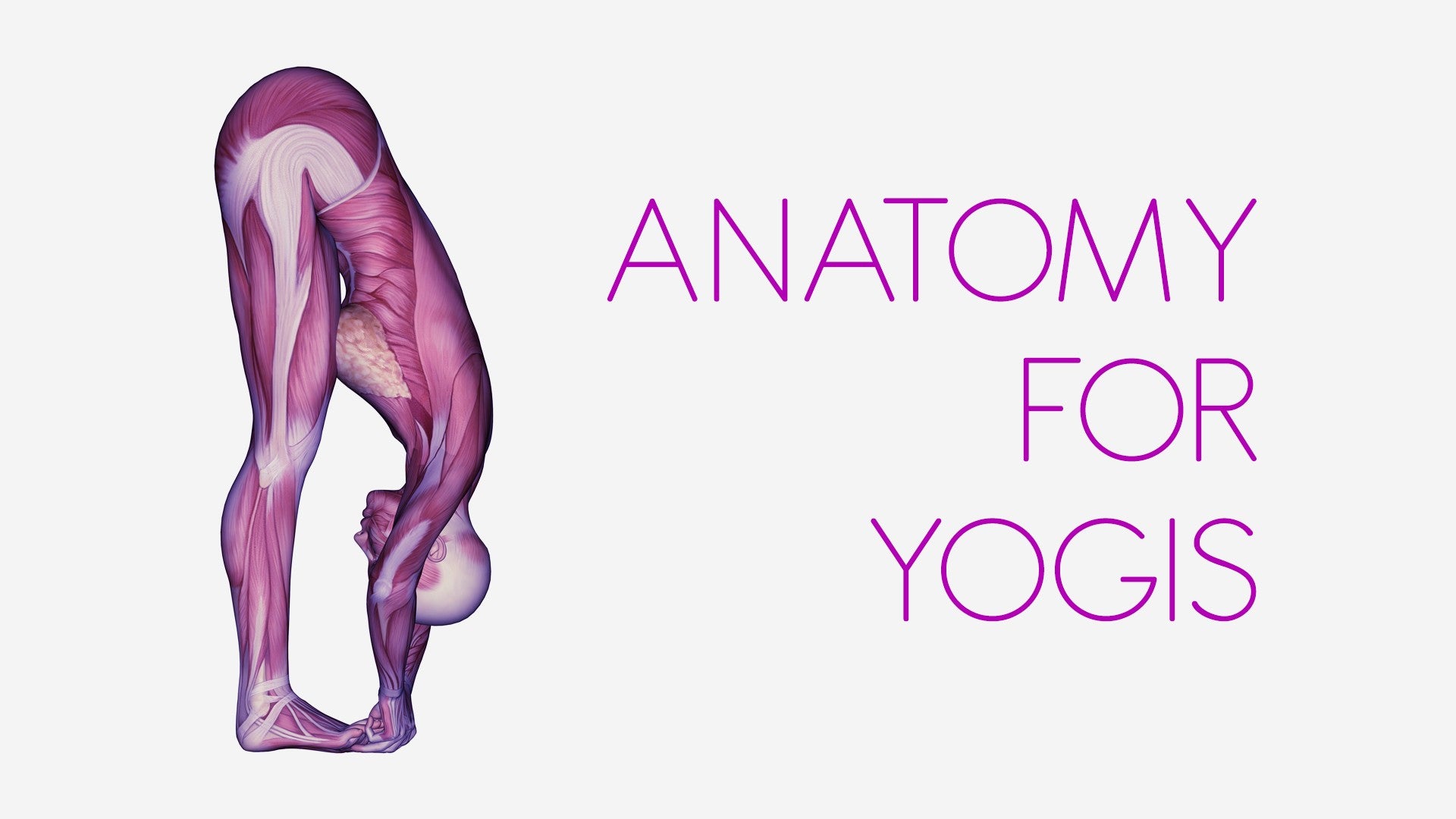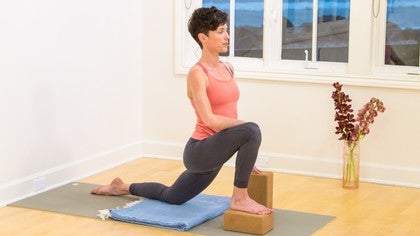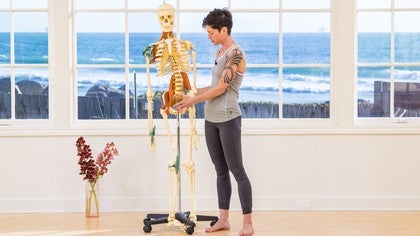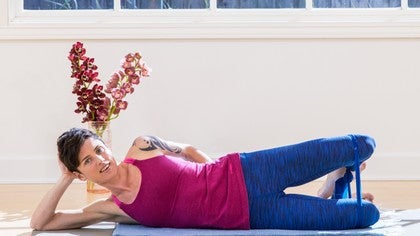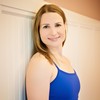Description
Transcript
Read Full Transcript
Hey, everyone. Welcome back. This is a short sequence to open the front of the hips. There's a couple of things about this sequence that I just want to say, first of all. For those of us who are working with hypermobility and tend to overstretch or risk overstretching, it's really important to know what we're working with. And particularly with lunging, especially deep lunging, if you have a tendency towards overstretching, lunges can be some of the most problematic postures. So today we're going to work with awareness of the pathway of the psoas. And the psoas is actually the only muscle in your body that literally connects your trunk or torso to your legs. It's also a muscle that connects your back body to your front body. For those of us in tighter bodies, it's also really important to know what we're working with. Different reasons apply. You might not have the same risk of overstretching, but it's still really helpful to know where to direct your attention and where to direct your energy so that you can work efficiently in your posture. So to begin, I just want to talk about where the psoas is. Go ahead and find the front of your ribs where they connect in your front. And trace them down, follow the curve of them down, all the way to your spine. Now, there's a sheet of muscle that connects all the way around the circumference of your bottom ribs. And this muscle is called your diaphragm. It separates your upper viscera, your lungs and your heart from your digestive organs, all your guts below it. When you inhale, your diaphragm spreads and presses down. That's why you can get a belly breath. And when you exhale, your diaphragm contracts and lifts in and up. Now, connecting to the cura of your diaphragm or the connecting fibers is where the top of your psoas is. And your psoas runs along the length of your spine, your lower spine, on the right and the left sides. So if you find your lower ribs, again, you trace around to where your spine is, you can probably feel the bony bumps at the back of your spine. Now, where your psoas attaches is actually about two inches forwards of what you can feel at your back. And it attaches on the sides of what are called the vertebral bodies. And the front of your spine here is almost at the center of your body, which is kind of crazy to think about. Like a lot of times when I think of the spine or when people think of the spine, they think of their back. However, the front of your spine is fairly far forwards into the center of your body. And how these muscles attach is to the sides of the vertebral body. So again, about this height. And they start at your lumbar spine, just above your belly button, and then travel down the length of your spine. And right about at your hip area, they meet up with another muscle called the iliacus. And if you feel your hip crest, so from the point in front all the way up over kind of the ridge of your upper hip and where your hip then attaches to your spine at your sacrum, lining the inside of that bone is a muscle called the iliacus. And it has kind of a fan shape. And when the psoas meets the iliacus, it becomes what people often refer to as the iliopsoas. And then both of these muscles attach at your upper inner thigh. And your upper inner thigh bone is so deep within your body that you can't palpate it. But we'll be doing a little bit of work to figure out where it is. But one way to start to get a sense of where it is is either the corners of your pubic bones, which you might be able to feel, or if you bring your hand to your bum and you find your sitz bones, the bony bones you sit on, the upper inner thigh bone is slightly forwards and in from where you feel your sit bones. So the iliopsoas attach at what's called the lesser trochanter and it's a little knob at your upper inner thigh bone. So in this way the psoas line travels slightly back to front and it connects your deep spine to the top of your legs. So that's the terrain that we're working in today. We're going to start with a really simple supported bridge pose. You'll want a block. So go ahead and come onto your back and then you can place your block at either the lower or the middle height just underneath your sacrum. Keep your feet about hips-width distance apart and on the floor.
So in this pose we'll just start to think about how this muscle travels and you might even use your hands and just mirror what I'm doing. So you can start with your hands at your back body close to your spine and then brush your fingertips out to the sides, around and then towards your inner thighs. And the curve of the psoas isn't this big, it's not this extreme, but the movement of it mirrors this kind of spreading in the back body, a widening from midline out to the sides and then a deepening in the front body. And if you were to think of your body more artistically you could think of like strokes of paint brushes moving horizontally from your spine out to the sides at your back and then wrapping around the front and traveling vertically from the top of your hips towards your inner thighs. So the back body is wide and broad and the front body is deep and narrows. So with that in your awareness just let your arms rest and you might want to close your eyes and see if now you can kind of get that sense in your inner body. So your lower belly can rest towards your back and you can think about widening and spreading the inner surface of your back body. And then wrapping around the front of your hips and starting to reach lengthwise down from the outer hips in towards your pubic bones and then into your inner thighs. Now move your feet just a touch closer in so that you can press down into your feet and lift the weight of your pelvis off the block just a little bit and then set it back down. So make sure that your feet are in the right place. Now we'll do that again we'll lift the pelvis up and what I want you to feel as you lift the pelvis up is that the back of your body is widening and spreading and then wrapping around towards your inner thighs and that the skin of your inner thighs travels towards your knees and then come back down. So one more time can you push down through your feet feel that your hamstrings work but that your lower back spreads and broadens and that your inner hips and inner thighs deepen and inner thighs lengthen towards your knees and then come on down. Okay this time press into your feet just to lift the block and set it out to the side. So we're going to roll over onto the side I'm going to roll onto my right so that you can see the back of my body you can start on either side. You can bend your bottom elbow and let the heel of your hand support the base of your skull and here you can get a nice traction for the earthly side of your neck and then please bring your whatever knee is on top so for me it's my left I'm just going to bring my left knee forwards and set my knee down onto the floor and then from here I'll start to straighten my right leg and then I'll bend my right knee and reach back with my left hand to grab my right foot. What I'm looking for here is an opening through the front of my right hip joint and a lengthening of my right thigh or my right quadricep. You'll get more opening or more stretch sensation the further you take your right knee back in space. I can take my right knee a little bit further back and then you can wrap your heel of your hand around your toenails here and then draw the toes in towards the sole foot so that you actually kind of increase the length of the fascia at the front of your leg from the top of your hip all the way to your toes. Now if it feels good from here you can release your arm and let your chest roll open towards the ceiling. I want to think about lengthening and letting the movement of my skin travel all the way past my right toes here so from my right hip across the knee over my shin and all the way over my toes. And then we'll change to the second side so you can release that leg and roll over onto your second side supporting your head with your hand again you can take the top knee forwards bend to the bottom knee and reach back with your upper hand so for me it's my right. The further back in space you bring your bottom knee the more stretch sensation is available. Again it's an option to release your head down and start to roll your chest open. And there's a similar quality here as we explored in the first shape so for some of us if we have a lot of like really bendy back you might kind of feel that your belly is pouring forwards here and you can instead kind of just let the weight of your belly rest into your back body and feel that your back is spreading and that as you kind of open the left leg that there's also a deepening of the inner left hip and inner left thigh. So the person that taught me this pose calls it Netflix pose because it's a good one to watch Netflix and all right so come on up from here and grab your blocks. I'm going to place them at the top of your mat. I like to have a blanket to support my knee so I'll fold the blanket here just to cushion the back knee right so I'm going to start by bringing my right foot forwards and setting my blocks up so that they're below my shoulders and then from here I'm going to start to deepen my lunge and you'll notice that my knee is traveling forwards of my ankle. That's fine and the back hip the left front of the left hip is lengthening vertically so blocks are underneath my shoulders my chest can be upright. Now what I want to feel here is the same kind of sensation of spreading through my back body and on the left side from just behind my navel I'm spreading the back body around to the front of the hip and then at the front of the hip I feel the left inner hip deepening and now I'm actively reaching from the left inner hip to the left pubic bone and from the left pubic bone to the left inner thigh and as I find that reach I get a little deeper in the pose but my sensation is deeper into my body and I feel that I'm not hanging in the connective tissue at the front of my left hip. So let's come out of this side and change sides. Left knee coming forwards, left knee can travel forwards of the ankle. Okay so from the space behind my belly button I'm kind of letting my belly rest to my back body feeling my back body spread feeling the width of the back of my right hip wrapping around to the front of my right hip and then from the front of my right hip deepening so I'm kind of drawing a little bit of weight away from the earth and bringing it into my body and then reaching in the direction of my pubic bone and from pubic bone to the inner thigh and inner thigh all the way to the big toe okay and then I'm going to come out of this side and set up for lunge number two and here I'll take the right block and set it down on the first height and now I'll bring my right foot onto the right block and travel back into my lunge. Okay so I want to get my weight centered in my right hip joint and then on the back leg side from the back body I'm spreading and broadening around into the front body and then from the front of my left hip I'm reaching into the inner thigh deepening through the front of my left hip and reaching all the way into my left toes and come out of this side and change sides so these lunges you don't want to stay in too long maybe five breaths is plenty especially because we're doing three and especially if I'm sitting a lot like if I've been doing a lot of desk work sometimes I'll just take a pause and do these they're very potent very effective so from the back body wrapping around reaching from the front of the hip into the midline and then from the pubic bone through the inner thigh into the inner foot okay and then coming out all right so you ready for the third and final lunge so we're gonna have one block on the lower level and then one block on the middle level voila okay and then from here starting to come forwards okay and in this variation I can really work with the upright chest and I want to again spread the back body reach through the inner leg all the way to the big toe side and then come down switch your props the second side my weight is centered through the left hip and then as I let the left knee travel forwards I'm reaching from the back around to the front and through the inner leg you might be like me and have one side that's a lot tighter than the other okay and then come out so just to mention that if you do have one side that's a lot tighter than the other the rule for that is to start with your tighter side and then do an extra set on the tight side all right so let's take downward facing dog just for a couple of breaths so now in downward facing dog bring your attention into the same space so from the space behind your navel feel your back body spread and then feel how there's kind of a wrapping around into your front body and then a deepening through your inner thighs and reach from your inner thighs through your legs now the top of your psoas again is kind of continuous with the fibers of your diaphragm and it's important here to feel that the back of the diaphragm is also spreading so sometimes we let the ribs drop towards the floor here I'm going to encourage you to feel that the back of the diaphragm can spread and almost float up into the ceiling okay so notice the sensation in the front of your hips right now notice what's there and then we'll come back down onto the knees and we'll set up to move the orientation of my blanket sorry well set up in vajrasana or thunderbolt with one block between your heels and your sit bones so it's important here that no part of the block is touching my lower calf or achilles tendon okay so the pressure of the block is coming right onto the back of my heel bones now for those of you that are alternative medicine practitioners you might know what this thing is I do not but it was taught to me by my teacher that there's by one of my teachers that there is a reflex point at the back of the heel that corresponds to the lower psoas into the front of the hips and so we bring a little bit of pressure onto this space and it has this kind of magical release for the pelvis I've noticed this to be true in my own body so we'll sit here for a couple of breaths and let's practice parvatasana arms over here you can bring your hands to interlace and press the palms up towards the ceiling okay so again the back of the diaphragm continues to spread here there's a tendency to kind of thrust the ribs forwards in this pose and you can instead just let them rest back and then soften the elbows switch the lacing of your fingers and re-extend your elbows okay and then you can release your hands down move your block just sit back for a second enjoy your squish probably feels good after that and then we'll come back into downward facing dog okay and then notice the feeling at the front of the hips now allowing the back of the diaphragm to continue to spread I almost feel like I have little balloons at the front of my hips that are inflating and lifting my pelvis up and back my sensation after those poses and the block variation in Vajrasana is that downward dog feels a lot less effortful because I can get weight into my legs in a really different way and then when you're ready bring your knees to the floor and let's rest in child's pose just for a couple of breaths and then as you're ready you can roll up to set so those poses are pretty simple to throw into the middle of your day if you have a desk job or if you're sitting down a lot it's kind of nice to sprinkle them in sometimes and the front of our hips tend to get really tight obviously we live in a culture where we sit a lot it's also the first place in the body to register fear so because so as is this major muscle that walks and runs it's the thing that creates hip flexion when we get triggered or when we have a fear response that muscle gets information right away that it might be time to move so you might notice that if you're in a state of like hyper alertness or anxiety and you know I think if you live in the world and are exposed to traffic or anything like that there's probably a good chance that your nervous system is at least on somewhat of high alert taking some time just to bring openness into this part of your body can do wonders for relaxing and calming so to ground out and to finish our practice you can take any type of seat or lie down and close your eyes for a minute and let your awareness come back once more into your back body and you know we meet the world through our faces and through the front and the back of our body isn't a place where we really tend to pay that much attention unless it's hurting so in this moment can you just be more in the back of your body and feel that especially your the front of your brain can rest back and imagine that you have eyes at the back of your skull behind your heart behind your belly button and they're just very softly opening and perceiving so can bring your hands together and well imagine that the back body can kind of spread and wrap all the way around your entire body from the back to the front and as you bow your head to your heart feel that with through the back and deepening inwards at the front honoring this moment when you're ready lift your eyes and close your practice thank you
Anatomy for Yogis: Renee Sills
Comments
I was asking Alana M. to guide me to open my hips in a more balanced way. She sent me a link to your video and I am so glad that I found it. The question I have for you is this: How do you keep your hips from registering fear? you say the Psoas muscle is one of the muscle that does that? I work in an office in the health care field and this is where my fear is housed. My hips are so tight.
Thanks,
Carol
You need to be a subscriber to post a comment.
Please Log In or Create an Account to start your free trial.
